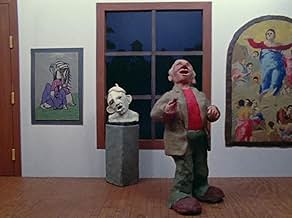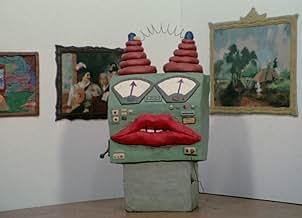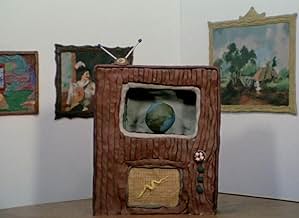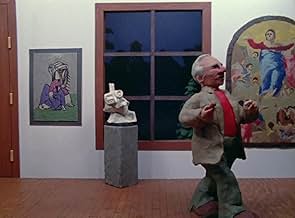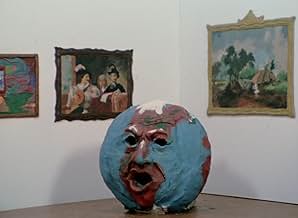अपनी भाषा में प्लॉट जोड़ेंA man visiting a museum sees the works of art come to life.A man visiting a museum sees the works of art come to life.A man visiting a museum sees the works of art come to life.
- 1 ऑस्कर जीते
- कुल 2 जीत
फ़ीचर्ड समीक्षाएं
Let's be blunt. The 1960s and 70s were terrible times for good animation. The excellent artwork of Looney Tunes and MGM were history and Disney was a sleeping giant which wouldn't really come back to life until "The Little Mermaid". In the meantime, third-rate animation studios like Hanna-Barbera churned out crap---cartoons with very low cel-counts (making the characters move like robots) and terrible stories (think "Speed Buggy", "The Harlem Globetrotters" and "Scrappy Do"). As a child and teen during this period, I pretty much watched the old classics in reruns and lost interest in the newer stuff. Thank goodness for the resurgence of animation!! Fortunatley, despite the nadir of the 60s-70s, occasionally a really great cartoon was produced against the odds. In other words, if bad and cheap animation paid, how could you expect anyone to bother with the good? Well, in the case of "Closed Mondays", you do get an exceptional short--even back in 1974.
"Closed Mondays" is an early animation of the Will Vinton Studios--the same folks who wore out their welcome in the 1980s with those annoying dancing raisins. It wasn't that the raisins were badly made--they were GREAT claymation characters. But, they were shown to death--with tons of commercials and even a kids cartoon series!! Talk about overkill....though I can't blame Vinton and the rest, as it did pay handsomely. But, they were capable of far more interesting stuff back in the 70s--such as "Mountain Music" and this short. These were terrifically animated using lumps of various colored clay--and very active imaginations.
The short begins with a wonderfully awful old guy wandering about an art museum. He seems to hate everything--which made me laugh. Even when the artwork comes to life, he seems unimpressed. And, in the end, it all makes a bit more sense. As I said, the quality of the work was very nice, the story was lovely AND it made me happy. Apparently the Academy also was impressed and they awarded the film the Oscar for Best Animated Short in 1975. See this one.
"Closed Mondays" is an early animation of the Will Vinton Studios--the same folks who wore out their welcome in the 1980s with those annoying dancing raisins. It wasn't that the raisins were badly made--they were GREAT claymation characters. But, they were shown to death--with tons of commercials and even a kids cartoon series!! Talk about overkill....though I can't blame Vinton and the rest, as it did pay handsomely. But, they were capable of far more interesting stuff back in the 70s--such as "Mountain Music" and this short. These were terrifically animated using lumps of various colored clay--and very active imaginations.
The short begins with a wonderfully awful old guy wandering about an art museum. He seems to hate everything--which made me laugh. Even when the artwork comes to life, he seems unimpressed. And, in the end, it all makes a bit more sense. As I said, the quality of the work was very nice, the story was lovely AND it made me happy. Apparently the Academy also was impressed and they awarded the film the Oscar for Best Animated Short in 1975. See this one.
A charming parable about thin border between life and art. A drinken man in an art gallery in evening. His discoveries , his experiences and the truths front to it.
A wise and seductive crafted short animation , a simple story about illusions and reality and one of perfect ends.
But the precious gift is the final feeling, a mix of nostalgia and tenderness , flavors of childhood and feeling of be older, both working in interesting manner together.
A parable, many. Useful for fair status of experience profound unique.
The result is a kick to reflection about significant things defining the life.
A wise and seductive crafted short animation , a simple story about illusions and reality and one of perfect ends.
But the precious gift is the final feeling, a mix of nostalgia and tenderness , flavors of childhood and feeling of be older, both working in interesting manner together.
A parable, many. Useful for fair status of experience profound unique.
The result is a kick to reflection about significant things defining the life.
It's the one-woman show of "Celia Crazelsnuk" that our visitor has come to view. It's supposed to be closed on Mondays, but armed with his bottle and a very limited knowledge of art - in he goes! There are paintings and there are sculptures - and when they start to come alive it gives him (and us) an opportunity to see some vibrant and quite emotional animations. These work well offering quite a wide variety of subject matter and even a very talkative robot, but it's the stop-motion of the man himself that's most impressive. The facial expressions and muscle definition is worthy or Ray Harryhausen himself. I loved the ending, too!
I saw this film on video when I was about seven years old. It was on a tape of various animated shorts, including "Sundae in New York". This was the last film to play, and I have to say I was astounded. Even as a child, I admired the haunting beauty of the animation, and the simple but surreal plot line. I already was a fan of Wil Vinton's work in "Return to Oz", but this film showed a unique creativity that still affects me to this day. I think that it is a crime that it is not available on DVD, and should be offered alongside some of Jan Svankmajer's work. The end (which I will not reveal) still makes me wonder about the nature of the man in the museum.
I've always preferred traditional animation to stop-motion/claymation. Whether it's Wilfred Jackson's 'The Old Mill (1937)' or Chuck Jones' 'What's Opera, Doc?,' classic animation indefinitely retains its timelessness and the ability to transport the viewer into a visual dimension entirely different from our own. When done correctly, claymation can, of course, be equally effective, but I didn't find this to be the case in 'Closed Mondays (1974),' an Oscar-winning short directed by Bob Gardiner and Will Vinton. When I looked at the old man in the art gallery, I wasn't transported into the film's world, but, rather, I recognised the character as a mass of shifting clay several inches in height and grimaced wryly as he shuffled across the floor in a completely awkward and unrealistic gait. The film contains some interesting ideas, but the animation is accomplished so clumsily that I was barred from entering its world; if films like 'A Grand Day Out with Wallace and Gromit (1989)' and 'Harvie Krumpet (2004)' were able to avoid these complications, then I'm less willing to cut this one some slack.
Nevertheless, I was certainly impressed with what 'Close Mondays' had to say about the nature of art. To consider each picture frame as a window into another world, filled with animate people and objects, is to add a new dimension to how one critically evaluates art. A masterpiece should possess the ability to make itself come to life before our eyes, and it is up to the viewer to contemplate the meaning of what we are seeing, and the events that might have led towards the image depicted in a painting. The frame of the lonely maid, forever condemned to solemnly scrub the cold stone floor, is almost heartbreaking in its poignancy; if only the remainder of the artworks were just as meaningful {I'm still trying to decide what that metamorphic super-computer was all about}. And, of course, I enjoyed the ending, confirming that behind every piece of art there is considerably more than initially meets the eye, an entire story just waiting to be told even if nobody is watching.
Nevertheless, I was certainly impressed with what 'Close Mondays' had to say about the nature of art. To consider each picture frame as a window into another world, filled with animate people and objects, is to add a new dimension to how one critically evaluates art. A masterpiece should possess the ability to make itself come to life before our eyes, and it is up to the viewer to contemplate the meaning of what we are seeing, and the events that might have led towards the image depicted in a painting. The frame of the lonely maid, forever condemned to solemnly scrub the cold stone floor, is almost heartbreaking in its poignancy; if only the remainder of the artworks were just as meaningful {I'm still trying to decide what that metamorphic super-computer was all about}. And, of course, I enjoyed the ending, confirming that behind every piece of art there is considerably more than initially meets the eye, an entire story just waiting to be told even if nobody is watching.
क्या आपको पता है
- ट्रिवियाThis short was included in the theatrical release of the compilation feature "Fantastic Animation Festival" (1977).
- इसके अलावा अन्य वर्जनThe version included in the video "Academy Award Winners - Animated Short Films" (released by Vestron Video) leaves out the words "Usual Crap" from the sign shown in the beginning of the film.
- कनेक्शनEdited into Fantastic Animation Festival (1977)
टॉप पसंद
रेटिंग देने के लिए साइन-इन करें और वैयक्तिकृत सुझावों के लिए वॉचलिस्ट करें
विवरण
इस पेज में योगदान दें
किसी बदलाव का सुझाव दें या अनुपलब्ध कॉन्टेंट जोड़ें

